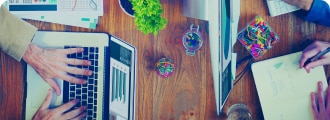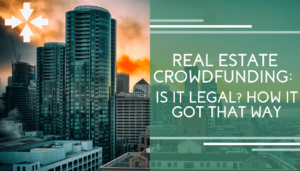Online Marketing Systems for Commercial Real Estate Professionals
By Adam Gower Ph.D.
If you’ve come from a traditional marketing background, jumping into online marketing may not feel like a stretch. But, if marketing is new territory for you or if you’re learning as you go, it’s time for a crash course in the purpose of online marketing and how to build an automated system that works.
The Core of Marketing
Marketing is all about knowing and understanding your customers, and meeting them where they are, wherever that may be. Online, it could be social media, email, podcasts, or anything else.To understand your investors, you need to go a bit deeper and uncover their intent, their motivations, and their interests. Ask questions like these:
• Who is the average person that makes up a part of your market?
• Where do they go?
• What do they like?
• What do they do?
• Are their interests aligned with what you’re doing?
Sales is the next step of marketing, which is actively trying to get people to invest with you. Marketing is only concerned with knowing who your customers are, understanding them, and getting your message in front of them; sales is converting them from being prospects into being investors.
Get access to our FREE weekly newsletter exclusively covering the latest updates from the real estate crowdfunding world
Reaching People Where They Are
Every channel online is just another place to reach your prospects. Some prospects hang out on Twitter, others on LinkedIn, others still on Facebook or YouTube. Wherever they are, you should be there too (and don’t worry, it’s not that difficult to do because you can automate the entire process). If your prospects prefer emailing to communicate, make sure you have a full-fledged (automated) email marketing strategy.
People may find you on their own if they’re specifically looking for the types of deals you offer, but it’s a long shot unless you have a killer SEO strategy in place, so you should never take that for granted. Put yourself in plain view, work to get in front of your prospects, and do what you can to attract the right kind of attention. You can only do this if you know where your prospects are and if you understand how they use their chosen online platforms.
Automating Your Marketing
A huge benefit you get from online marketing is the ability to collect and use data. Analytics and automation change the whole game for you. While you don’t have the visual cues or body language of a personal interaction, there are digital equivalents that make it easy to create automated pathways that cater to specific types of leads or customers.
Taking email marketing as an example, you can figure out how engaged someone is with you brand or your content by tracking how often they open your emails and what links they follow from within your emails. Prospects who open all your emails and visit pages on your site are far more engaged than people who only occasionally open emails and rarely visit your site pages. Knowing this helps you tailor your marketing strategy to accommodate the level of interest of each lead because you can build powerful hotlists of engaged prospects who you can follow up with proactively.
Automated marketing is powerful because it allows you to interact appropriately with many different types of people simultaneously. If you build up your system the right way, each distinct group of people will get messaging that makes sense for them through a channel that they already use regularly. However, for automation to work, you must build an effective underlying system.
Building Up Your Backend System
Ideally, your marketing automation system will be fully hands-off until crucial points of communication – which is when you need to hand-hold a prospect across the investment finishing line. There are two important pieces that make this happen:
1. Segmenting Your Market
You know your target market. While most of your materials may be aimed at your target market, do you have any idea who else is interacting with you that doesn’t fit into your ideal frameworks? For example, if you’re targeting accredited investors, do you have anything prepared to build and nurture a relationship with investor leads that aren’t yet accredited? Nurturing long-term relationships with these colder leads could turn them into hot leads once they match your target.
Segment your audience and interactions into as many categories as it makes sense to have, track their progress or interactions, then communicate with them specifically for their situation. Email marketing is the easiest example to demonstrate what this can look like. Based on interactions with you, or interactions to your welcome emails, you may classify one visitor as a mildly interested, accredited investor and another person as a highly engaged, non-accredited investor. Your system should have a way to sort people into the appropriate categories (i.e. scoring them based on responses to a survey or based on interactions) and automatically send them a certain sequence of emails that’s tailored to their situation.
You don’t want a non-accredited investor receiving an email sequence telling them how to invest in real estate, the benefits of your program, or any emails showing available investment projects, because they won’t be able to interact with those things. Similarly, you wouldn’t want to send high-net-worth prospects information that is tailored specifically to non-accredited investors – like tripwire investments with $5 minimums for example. Segment your audience properly, then make sure your automated system recognizes and responds to those segments appropriately.
2. Developing In-Flow
How do people get into your eco-system? For automation to work, there should be in-flow channels that don’t rely on you always reaching out and connecting with new leads. Opt-in forms are a great tool, as long as you build them in a way that gives you all the information you need to get started. That said, you also want to be making it as easy as possible to get the all important first name and email address from a prospect so at first contact, that’s all you should be asking for. You can wait until later to ask for phone number or other information relevant to your marketing program.
Short surveys or questionnaires are also appropriate for people who are interested in investing and can be highly informative. Based on their responses, your system should be able to sort them into their appropriate segment and give them the right marketing sequence, plus you can tailor your marketing strategy around the responses you get in your surveys.
There should be in-flow channels present everywhere that you operate online. Your website, social media, and even marketing emails should all have a logical pathway to lead people into the next steps forward, when appropriate. This is where call-to-actions (CTAs) are important. Soft or hard CTAs should help people get connected to your automated marketing campaigns, so you can keep them in the loop without having to make in-person connections every time.
***
There’s no secret to making marketing work for everyone. If you break down online marketing to its basics, it’s essentially a system built around understanding people so you can send them the right messages through the right channels. Knowing this, it’s time to evaluate your online presence so you can start down the path of understanding, segmenting, and automation. Done properly, you can raise potentially unlimited capital for your projects now and deep into the future.
If you have only just started in real estate development, have completed no deals, have no email list, but know you want the freedom and wealth being a real estate developer brings, then I suggest your first step is to start evaluating deals so you can recognize a good one when you see it.
Here’s where you should start. You’ll learn everything you need to know – the different types of real estate, different development strategies, how real estate cycles influence the market, and all about due diligence.
If you want to find deals and raise money for them so you can start your real estate development business, then learning how to conduct due diligence so you can pitch your deals better to investors is a great place to start.
If you’ve already purchased one or more real estate project and are seeing more opportunities than you can finance, then now is the time to start building your investor network so you can finance all your next deals quicker.
You’ve already got some momentum; now start finding and educating prospects about what you’re doing so you can build an email list of people to pitch to when you’re ready to raise money for your next deal.
This is what we build for private clients all the time – it’s called the Investor Acquisition System and you can access the entire program right here so you can find prospects, and convert them into being deep pocketed, repeat investors in your deals.
If you are a seasoned pro with multi-cycle experience, a substantial portfolio, a decent deal pipeline, and find yourself spending too much time raising equity capital because you’re still doing it in-person, then it’s time you put technology to work for you.
The wonderful thing about doing this is that you’re not going to be doing anything different than you’re already doing and, guess what, you’ll never have to sit through investor meetings again.
Sounds crazy I know, but I lay the whole thing out for you in this white board workshop where I personally show you exactly what it takes for you to transform your equity raising into a fully automated, capital raising machine so you can find new investors while increasing commitments from your existing network.






